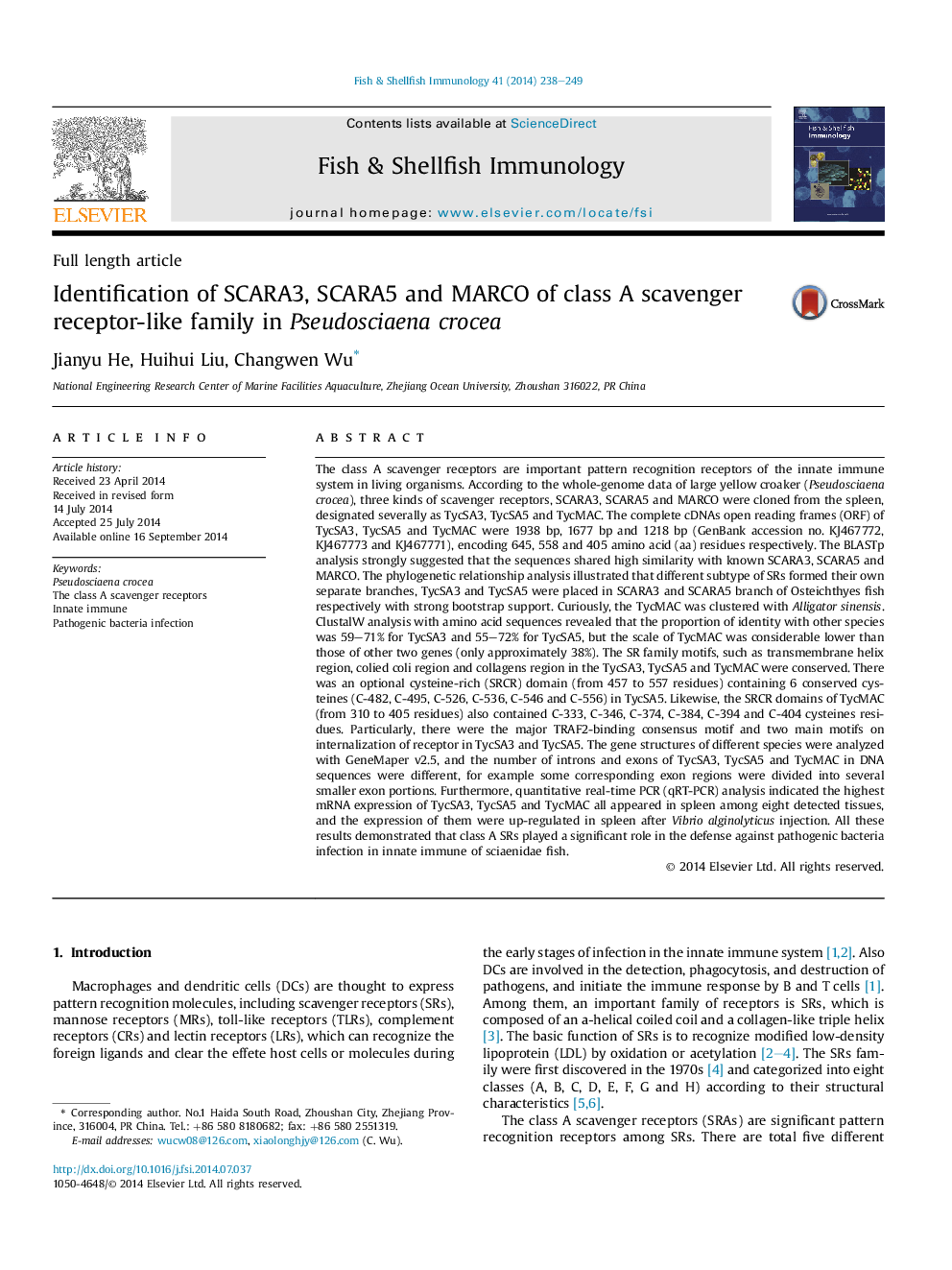| کد مقاله | کد نشریه | سال انتشار | مقاله انگلیسی | نسخه تمام متن |
|---|---|---|---|---|
| 2430933 | 1106740 | 2014 | 12 صفحه PDF | دانلود رایگان |

• SCARA3, SCARA5 and MARCO (TycSA3, TycSA5 and TycMAC) were identified from Pseudosciaena crocea.
• The numbers of intron and exon in TycSA3, TycSA5 and TycMAC were different from other species.
• The domains in TycSA3, TycSA5 and TycMAC were conserved.
• Their temporal mRNA expression were up-regulated after challenge of Vibrio alginolyticus.
• The results might be conducive to comprehend innate immune system of bony fish.
The class A scavenger receptors are important pattern recognition receptors of the innate immune system in living organisms. According to the whole-genome data of large yellow croaker (Pseudosciaena crocea), three kinds of scavenger receptors, SCARA3, SCARA5 and MARCO were cloned from the spleen, designated severally as TycSA3, TycSA5 and TycMAC. The complete cDNAs open reading frames (ORF) of TycSA3, TycSA5 and TycMAC were 1938 bp, 1677 bp and 1218 bp (GenBank accession no. KJ467772, KJ467773 and KJ467771), encoding 645, 558 and 405 amino acid (aa) residues respectively. The BLASTp analysis strongly suggested that the sequences shared high similarity with known SCARA3, SCARA5 and MARCO. The phylogenetic relationship analysis illustrated that different subtype of SRs formed their own separate branches, TycSA3 and TycSA5 were placed in SCARA3 and SCARA5 branch of Osteichthyes fish respectively with strong bootstrap support. Curiously, the TycMAC was clustered with Alligator sinensis. ClustalW analysis with amino acid sequences revealed that the proportion of identity with other species was 59–71% for TycSA3 and 55–72% for TycSA5, but the scale of TycMAC was considerable lower than those of other two genes (only approximately 38%). The SR family motifs, such as transmembrane helix region, colied coli region and collagens region in the TycSA3, TycSA5 and TycMAC were conserved. There was an optional cysteine-rich (SRCR) domain (from 457 to 557 residues) containing 6 conserved cysteines (C-482, C-495, C-526, C-536, C-546 and C-556) in TycSA5. Likewise, the SRCR domains of TycMAC (from 310 to 405 residues) also contained C-333, C-346, C-374, C-384, C-394 and C-404 cysteines residues. Particularly, there were the major TRAF2-binding consensus motif and two main motifs on internalization of receptor in TycSA3 and TycSA5. The gene structures of different species were analyzed with GeneMaper v2.5, and the number of introns and exons of TycSA3, TycSA5 and TycMAC in DNA sequences were different, for example some corresponding exon regions were divided into several smaller exon portions. Furthermore, quantitative real-time PCR (qRT-PCR) analysis indicated the highest mRNA expression of TycSA3, TycSA5 and TycMAC all appeared in spleen among eight detected tissues, and the expression of them were up-regulated in spleen after Vibrio alginolyticus injection. All these results demonstrated that class A SRs played a significant role in the defense against pathogenic bacteria infection in innate immune of sciaenidae fish.
Journal: Fish & Shellfish Immunology - Volume 41, Issue 2, December 2014, Pages 238–249